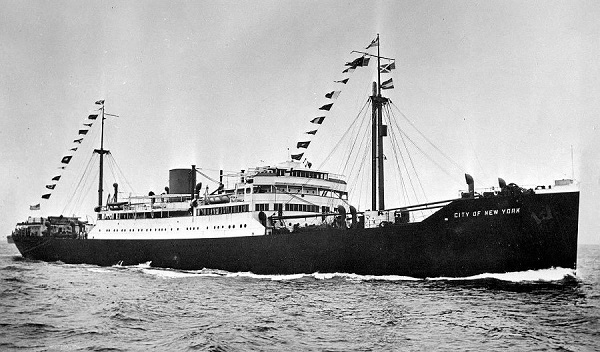City of New York
American Motor passenger ship

| Name | City of New York | ||
| Type: | Motor passenger ship | ||
| Tonnage | 8,272 tons | ||
| Completed | 1930 - Sun Shipbuilding & Dry Dock Co, Chester PA | ||
| Owner | American-South African Line Inc, New York | ||
| Homeport | New York | ||
| Date of attack | 29 Mar 1942 | Nationality: | |
| Fate | Sunk by U-160 (Georg Lassen) | ||
| Position | 35° 16'N, 74° 25'W - Grid CA 8781 | ||
| Complement | 132 (26 dead and 106 survivors). | ||
| Convoy | |||
| Route | Lourenço Marques - Capetown - Port of Spain, Trinidad - New York | ||
| Cargo | 6612 tons of chrome ore, wood, wool, hides and asbestos | ||
| History | Completed in January 1930 and made her maiden voyage in February as the first ship of the American-South African Line. | ||
| Notes on event | At 19.36 hours on 29 March 1942 the unescorted City of New York (Master George T. Sullivan) was hit by one G7a torpedo from U-160 about 50 miles east of Cape Hatteras, while she steamed in twenty-foot seas on a non-evasive course at 14 knots. The torpedo struck after a running time of just 29 seconds on the port side at the waterline at #3 hold just below the bridge and destroyed one of the lifeboats. The helmsman brought the ship into the wind and the watch below secured the engines. The armed guards fired twelve shots with the 4in gun on the poop (the ship was also armed with four .50cal and four .30cal guns) at the periscope. The U-boat circled the stern at a distance of about 250 yards and fired off the starboard quarter another torpedo as coup de grâce at 19.47 hours that struck on the starboard side at #4 hold, causing the ship to sink by the stern about 20 minutes after the first hit. In the meantime, the most of the 13 officers, 69 crewmen and 41 passengers abandoned ship in four lifeboats after a fifth overturned during launch. The nine armed guards followed them by jumping off the ship when the water reached the after deck and swam to the boats or two rafts that floated free. The next day, two USAAF bomber and a USN PBY Catalina flying boat searched the area of the sinking but found no survivors. USS Greer (DD 145) and USS Roper (DD 147) were also sent to investigate and the latter picked up 70 survivors (60 men, six women and four children) from two lifeboats and two rafts in approx. position 35°41N/73°39W between 00.10 and 04.30 hours on 31 March, but one crew member died on board after being rescued. The same day 26 other survivors, including the master, were picked up from a third boat by USS Acushnet (AT 63) and all survivors were taken to the Naval Base in Norfolk, Virginia. In the morning of 11 April, a USAAF bomber spotted the fourth lifeboat that had been launched with 13 crew members, one armed guard and six passengers (four women, one man and a 3-year-old girl), but five crew members, the armed guard, the man and two women died of exposure. The USN blimp K-4 took over in the afternoon and directed the US Coast Guard vessel USCGC CG-455 to the boat, which picked up eleven survivors and two bodies (the mother of the child and the armed guard, who had died only a few hours before the rescue) in position 38°42N/72°58W and took them to Lewes, Delaware. In all, 16 crewmen, one armed guard and nine passengers died. The “lifeboat baby” Jesse Roper Mohorovicic One of the passengers was Desanka Mohorovicic, the pregnant wife of an attaché to the Yugoslav consulate in New York, who travelled with her daughter Vesna. They went into a lifeboat together after the ship was torpedoed, but while waiting for rescue she went into labor. Luckily the ship’s surgeon, Leonard Hudson Conly, had followed her into the same boat and delivered the baby in the bottom of the lifeboat that was tossed about in 15 foot waves, even though he himself had two broken ribs. They were rescued by USS Roper the next day and the mother decided to name her son Jesse Roper after the namesake of the destroyer that picked them up. | ||
| On board | We have details of 49 people who were on board. | ||
If you can help us with any additional information on this vessel then please contact us.
